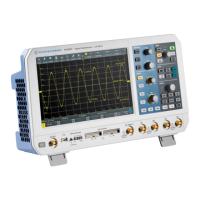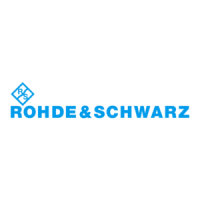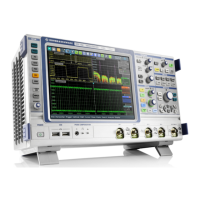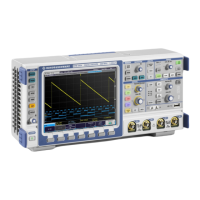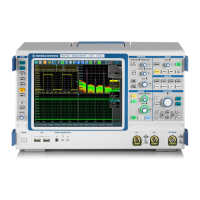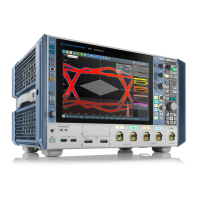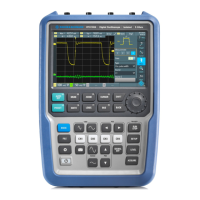Operating the Instrument
R&S
®
RTO2000
77Getting Started 1332.9719.02 ─ 08
1 = Vertical scale
2 = Vertical position
3 = Coupling and Termination
4 = Acquisition mode
5 = Offset
6 = Actual bandwidth, can be less than the instrument bandwidth depending on the number of active chan-
nels and other settings
If the sidebar contains many icons and not all icons are visible, touch one of the icons
and move it up or down until the required icon appears.
You can also switch off the sidebar: "Display" menu > "Diagram Layout" > "Show signal
bar" .
Trigger position and trigger level (4, 5)
The blue markers show the horizontal position of the trigger and the vertical trigger
level. You can touch and move the trigger markers in the diagram to set the positions.
The trigger point is the zero point of the diagram.
The trigger position can be moved outside the diagram. A red trigger position marker
indicates that the trigger position is not visible.
Reference point (6)
The reference point marks the rescaling center. If you modify the time scale, the refer-
ence point remains fixed on the screen, and the scale is stretched or compressed to
both sides of the reference point.
You can define the position of the reference point (Horizontal), and its time distance
from the trigger point of the diagram (Position).
Zoom diagram and zoom area (7, 8)
Zoomed waveforms are shown in separate zoom diagrams, in addition to the waveform
diagrams. On the original waveform diagram, a rectangle indicates the zoomed section
of the waveform - this is the zoom area. You can modify the zoom area by dragging the
rectangle as a whole, and by dragging its edges. To toggle between these modes, tap
the zoom area. You can also set exact positions.
The frames of the zoom area and of the associated zoom diagram have the same
color, different zooms are marked with different colors. So it is easy to assign zoom
area and zoom diagram.
As for waveform diagrams, you can change the name of the zoom diagram. A zoom in
a zoom and coupled zooms are also possible.
All zooming possibilities are described in detail in the User Manual, chapter "Zoom".
Histogram and histogram area (9, 10)
A histogram shows the frequency of occurrence of voltage or time values in a bar chart
directly in the diagram. The rectangular histogram area indicates the part of the wave-
form that is considered in the histogram. The vertical histogram counts the voltage val-
ues, and the horizontal histogram counts time values. You can switch between vertical
and horizontal mode, and modify the histogram area by dragging the rectangle as a
whole, by dragging its edges, or by setting exact positions.
Touchscreen Display
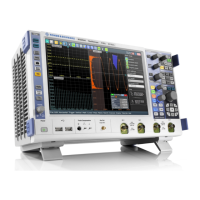
